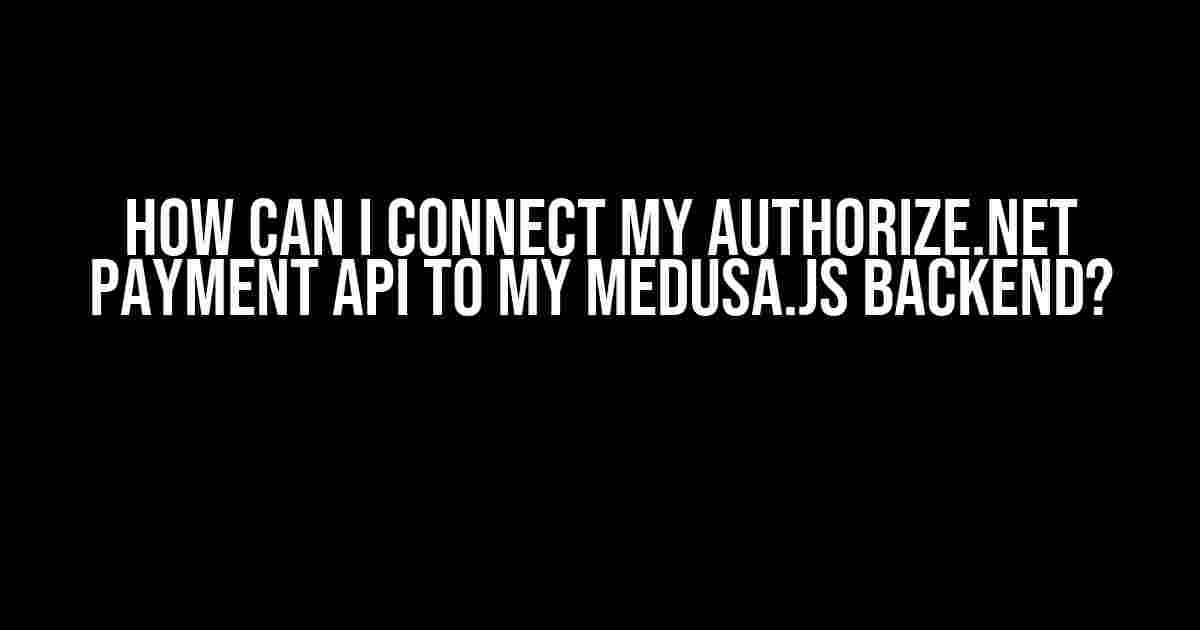Are you tired of juggling multiple payment gateways and still struggling to integrate Authorize.net with your Medusa.js backend? Fear not, dear developer, for we’ve got you covered! In this comprehensive guide, we’ll walk you through the step-by-step process of connecting your Authorize.net payment API to your Medusa.js backend, ensuring a seamless payment experience for your customers.
- What is Authorize.net?
- What is Medusa.js?
- Why Integrate Authorize.net with Medusa.js?
- Prerequisites
- Step 1: Install Required Dependencies
- Step 2: Set up Authorize.net API Credentials
- Step 3: Create an Authorize.net Payment Gateway in Medusa.js
- Step 4: Register the Authorize.net Payment Gateway in Medusa.js
- Step 5: Integrate Authorize.net with Medusa.js Checkout
- Troubleshooting and Testing
- Conclusion
What is Authorize.net?
Authorize.net is a popular payment gateway that enables businesses to accept online payments securely and efficiently. With its robust API, you can integrate Authorize.net with your ecommerce platform, allowing customers to make payments using various payment methods, such as credit cards, e-checks, and digital payments.
What is Medusa.js?
Medusa.js is a headless ecommerce framework built on Node.js, designed to provide a flexible and customizable ecommerce solution. By decoupling the frontend and backend, Medusa.js allows developers to create unique, scalable, and high-performance ecommerce experiences.
Why Integrate Authorize.net with Medusa.js?
Integrating Authorize.net with Medusa.js offers a plethora of benefits, including:
- Enhanced security: Authorize.net’s robust security features ensure that sensitive payment information is protected, complying with industry standards like PCI-DSS.
- Increased payment options: By integrating Authorize.net, you can offer customers a wide range of payment methods, improving the overall shopping experience.
- Streamlined payments: Automate payment processing, reducing manual errors and minimizing the risk of payment failures.
- Scalability: Medusa.js’s headless architecture and Authorize.net’s scalable API ensure that your ecommerce platform can handle high traffic and large transaction volumes.
Prerequisites
Before we dive into the integration process, ensure you have the following:
- An Authorize.net account with API credentials (API login ID and transaction key)
- A Medusa.js backend set up with Node.js and a compatible database (e.g., PostgreSQL)
- Familiarity with JavaScript, Node.js, and Medusa.js
Step 1: Install Required Dependencies
To integrate Authorize.net with Medusa.js, you’ll need to install the following dependencies:
npm install --save authorize-net-sdkThis package provides a Node.js SDK for Authorize.net, making it easier to interact with the API.
Step 2: Set up Authorize.net API Credentials
Create a new file in your Medusa.js project, e.g., `authorize-net.config.js`, to store your Authorize.net API credentials:
module.exports = {
apiLoginId: 'YOUR_API_LOGIN_ID',
transactionKey: 'YOUR_TRANSACTION_KEY',
};Replace `YOUR_API_LOGIN_ID` and `YOUR_TRANSACTION_KEY` with your actual Authorize.net API credentials.
Step 3: Create an Authorize.net Payment Gateway in Medusa.js
In your Medusa.js project, create a new file, e.g., `payment-gateways/authorize-net.gateway.js`, to define the Authorize.net payment gateway:
import { PaymentGateway } from '@medusajs/medusa';
import { AuthorizeNetAPI } from 'authorize-net-sdk';
const authorizeNetConfig = require('./authorize-net.config');
class AuthorizeNetGateway extends PaymentGateway {
constructor() {
super('authorize_net');
}
async initialize() {
this.authorizeNetApi = new AuthorizeNetAPI(authorizeNetConfig.apiLoginId, authorizeNetConfig.transactionKey);
}
async createPaymentMethod(paymentMethod) {
// Implement payment method creation logic using Authorize.net API
}
async processPayment(payment) {
// Implement payment processing logic using Authorize.net API
}
async refundPayment(payment) {
// Implement payment refund logic using Authorize.net API
}
}
export default AuthorizeNetGateway;This example defines a basic Authorize.net payment gateway for Medusa.js, utilizing the `authorize-net-sdk` package to interact with the Authorize.net API. You’ll need to implement the `createPaymentMethod`, `processPayment`, and `refundPayment` methods according to your specific requirements.
Step 4: Register the Authorize.net Payment Gateway in Medusa.js
In your Medusa.js project, update the `medusa.config.js` file to register the Authorize.net payment gateway:
module.exports = {
// ...
paymentGateways: [
{
id: 'authorize_net',
gateway: AuthorizeNetGateway,
},
],
};This registers the Authorize.net payment gateway with Medusa.js, making it available for use in your ecommerce platform.
Step 5: Integrate Authorize.net with Medusa.js Checkout
To integrate Authorize.net with Medusa.js checkout, you’ll need to update the checkout logic to use the Authorize.net payment gateway. This will vary depending on your specific implementation, but typically involves:
- Retrieving the payment method from the customer
- Creating a payment using the Authorize.net API
- Processing the payment using the Authorize.net API
- Handling payment success or failure responses
Here’s a simplified example of how you might integrate Authorize.net with Medusa.js checkout:
import { CheckoutService } from '@medusajs/medusa';
import { AuthorizeNetGateway } from './payment-gateways/authorize-net.gateway';
const checkoutService = new CheckoutService();
// ...
async function handleCheckout(req, res) {
const paymentMethod = req.body.paymentMethod;
const authorizeNetGateway = new AuthorizeNetGateway();
try {
const payment = await authorizeNetGateway.createPaymentMethod(paymentMethod);
const paymentResponse = await authorizeNetGateway.processPayment(payment);
if (paymentResponse.success) {
// Handle payment success
} else {
// Handle payment failure
}
} catch (error) {
// Handle error
}
}This example demonstrates how to integrate Authorize.net with Medusa.js checkout, but you’ll need to adapt it to your specific use case.
Troubleshooting and Testing
When integrating Authorize.net with Medusa.js, you may encounter issues or errors. To troubleshoot and test your implementation, follow these tips:
- Enable debug logging in your Medusa.js project to inspect API requests and responses.
- Use the Authorize.net API sandbox environment to test transactions and simulate errors.
- Verify that your Authorize.net API credentials are correct and up-to-date.
- Check for compatibility issues between your Medusa.js version and the `authorize-net-sdk` package.
Conclusion
By following this comprehensive guide, you’ve successfully connected your Authorize.net payment API to your Medusa.js backend. This integration enables you to provide a streamlined payment experience for your customers, while ensuring the security and scalability of your ecommerce platform.
Remember to test your implementation thoroughly and troubleshoot any issues that arise. With Authorize.net and Medusa.js working together, you’re ready to take your ecommerce business to the next level!
| Authorize.net API Endpoint | Description |
|---|---|
createCustomerProfile |
Creates a customer profile in Authorize.net |
createPaymentMethod |
Creates a payment method in Authorize.net |
chargePaymentMethod |
Charges a payment method in Authorize.net |
refundPayment |
Refunds a payment in Authorize.net |
This table provides an overview of some common Authorize.net API endpoints you may use when integrating with Medusa.js. For a complete list of endpoints and their documentation, refer to the Authorize.net API documentation.
Frequently Asked Question
Get ready to unlock the power of Authorize.net payment API and integrate it with your Medusa.js backend!
What are the required credentials to connect my Authorize.net payment API to my Medusa.js backend?
To get started, you’ll need your Authorize.net API Login ID, Transaction Key, and Signature Key. You can find these credentials in your Authorize.net account settings. Make sure to keep them secure, as they grant access to your payment gateway!
Which Medusa.js plugin do I need to install to connect with Authorize.net?
You’ll need to install the `@medusajs/plugin-authorize-net` plugin. This plugin provides the necessary functionality to integrate Authorize.net with your Medusa.js backend. Simply run `npm install @medusajs/plugin-authorize-net` or `yarn add @medusajs/plugin-authorize-net` in your terminal, and you’re good to go!
How do I configure the Authorize.net plugin in my Medusa.js backend?
After installing the plugin, you’ll need to add the Authorize.net configuration to your Medusa.js backend. Create a new file `authorize-net.js` in your `medusa/plugins` directory, and add the necessary configuration options, such as your API Login ID, Transaction Key, and Signature Key. Then, import the plugin in your `medusa.js` file, and you’re all set!
Do I need to implement additional logic to handle payment processing with Authorize.net?
Yes, you’ll need to implement additional logic to handle payment processing, such as capturing payments, handling refunds, and updating order statuses. You can use Medusa.js’s built-in payment processing hooks to integrate with Authorize.net’s API. This will ensure seamless payment processing and order management in your Medusa.js backend.
Can I use Authorize.net’s test mode to test my payment integration?
Absolutely! Authorize.net provides a test mode that allows you to test your payment integration without processing real transactions. Simply set the `testMode` option to `true` in your Authorize.net configuration, and you’ll be able to test your payment flow without worrying about actual transactions. This is a great way to ensure your integration is working correctly before going live!


